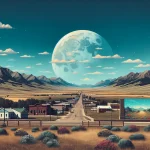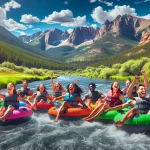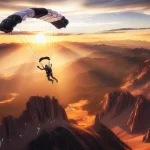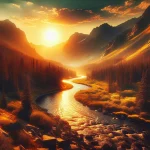South Fork Beaver Creek, located in the heart of Colorado’s stunning natural landscape, offers a wealth of outdoor activities and breathtaking scenery for visitors to enjoy. This hidden gem boasts over 20 miles of pristine waterways, making it a prime destination for fishing enthusiasts and nature lovers alike.
In This Article
TL;DR
- Exploration of diverse outdoor activities available in the area.
- Insight into the unique fishing opportunities South Fork Beaver Creek offers.
- Overview of the natural beauty and wildlife that enhances the visitor experience.
Exploring the Great Outdoors
South Fork Beaver Creek’s landscape is characterized by lush forests, rolling hills, and crystal-clear streams. Visitors can immerse themselves in the beauty of the area by hiking along the numerous trails that wind through the wilderness. Some of the most popular hiking destinations include:
- Beaver Creek Trail: A moderate 4-mile hike that follows the creek and offers stunning views of the surrounding mountains.
- Aspen Grove Trail: A challenging 6-mile trek that takes hikers through groves of aspen trees and rewards them with panoramic vistas of the valley below.
For those who prefer a more relaxed outdoor experience, South Fork Beaver Creek offers several campgrounds nestled in the heart of the forest. The Upper Beaver Creek Campground and Lower Beaver Creek Campground provide a perfect base for exploring the area and enjoying the tranquility of nature.
The Allure of Fishing
South Fork Beaver Creek is renowned for its exceptional fishing opportunities. The creek is home to a thriving population of rainbow, brown, and brook trout, making it a paradise for anglers of all skill levels. The best times to fish are during the spring and fall months when the water levels are optimal, and the fish are most active.
In order to ensure a successful fishing experience, it’s essential to use the right techniques and equipment. Fly fishing is the most popular method in South Fork Beaver Creek, with anglers using a variety of flies to mimic the natural insects found in the area. It’s also crucial to practice catch-and-release to maintain the health of the fish population and preserve the natural habitat for future generations.
Wildlife and Nature Photography
In addition to its stunning landscapes, South Fork Beaver Creek is home to a diverse array of wildlife. Visitors can spot everything from majestic elk and deer to playful otters and beavers. The area is also a haven for birdwatchers, with over 200 species of birds calling the region home.
For those interested in capturing the beauty of wildlife and landscapes, South Fork Beaver Creek offers endless opportunities for nature photography. Some tips for successful wildlife photography include:
- Using a long lens to maintain a safe distance from the animals.
- Being patient and waiting for the perfect shot.
- Respecting the animals' natural habitat and avoiding any actions that may disturb them.
Adventure Sports and Activities
South Fork Beaver Creek offers a range of adventure sports for thrill-seekers. Kayaking and whitewater rafting are popular activities during the summer months, with several local outfitters providing guided tours and equipment rentals. Mountain biking is another favorite pastime, with trails ranging from gentle paths to challenging single-track routes.
In order to ensure a safe and enjoyable experience, it’s essential to have the proper gear and follow safety guidelines. Always wear a helmet when biking or kayaking, and be prepared for changing weather conditions by bringing appropriate clothing and supplies.
Local Culture and Historical Sites
South Fork Beaver Creek has a rich history dating back to the early days of Colorado’s settlement. The area was once a thriving mining community, with several historic sites still standing today. Visitors can explore the remnants of old mining camps and learn about the region’s fascinating past at the local museum.
The community also celebrates its heritage through various events and festivals throughout the year. The annual Beaver Creek Music Festival, held in July, showcases local talent and brings the community together for a weekend of music and fun.
Environmental Conservation Efforts
Preserving the natural beauty of South Fork Beaver Creek is a top priority for both locals and visitors. Several organizations, such as the Colorado Parks and Wildlife Department and the Beaver Creek Watershed Council, work tirelessly to protect the area’s ecosystems and maintain the health of the waterways.
Visitors can contribute to these efforts by practicing Leave No Trace principles, which include packing out all trash, respecting wildlife, and minimizing campfire impacts. By being responsible stewards of the environment, we can ensure that South Fork Beaver Creek remains a pristine destination for generations to come.
Planning Your Visit
When planning a trip to South Fork Beaver Creek, it’s essential to consider the best times to visit based on your desired activities. Summer is ideal for hiking, camping, and adventure sports, while fall offers stunning foliage and excellent fishing opportunities.
There are several local accommodations available, ranging from cozy cabins to full-service resorts. For those looking to immerse themselves in nature, camping is popular, with the Upper Beaver Creek Campground and Lower Beaver Creek Campground as available options.
To make the most of your visit, consider booking guided tours or hiring local experts to help you navigate the area’s best-kept secrets. The South Fork Beaver Creek Visitor Center is an excellent resource for maps, trail information, and local recommendations.
FAQ
What are the best times of year to visit South Fork Beaver Creek for outdoor activities?
Summer and fall are the most popular seasons for outdoor activities in South Fork Beaver Creek. Summer offers warm weather and ideal conditions for hiking, camping, and adventure sports, while fall boasts stunning foliage and excellent fishing opportunities.
Can you fish year-round, and what are the regulations in South Fork Beaver Creek?
While fishing is possible year-round in South Fork Beaver Creek, the best times are during the spring and fall months when water levels are optimal and fish are most active. Anglers must obtain a valid Colorado fishing license and adhere to catch-and-release regulations to help maintain the health of the fish population.
What are some recommended safety precautions for hiking and camping in the area?
When hiking and camping in South Fork Beaver Creek, it’s essential to be prepared for changing weather conditions by bringing appropriate clothing and supplies. Always let someone know your planned route and expected return time, and carry a map, compass, and plenty of water. Be aware of wildlife and practice Leave No Trace principles to minimize your impact on the environment.
How can visitors contribute to the conservation efforts in South Fork Beaver Creek?
Visitors can contribute to conservation efforts by practicing Leave No Trace principles, which include packing out all trash, respecting wildlife, and minimizing campfire impacts. Supporting local organizations dedicated to preserving the area’s natural beauty, such as the Beaver Creek Watershed Council, is another way to make a positive impact.
Are there guided tours available to explore South Fork Beaver Creek’s natural and historical sites?
Yes, several local outfitters offer guided tours to explore the area’s natural wonders and historical sites. These tours provide insight into the region’s fascinating past and help visitors navigate the best-kept secrets of South Fork Beaver Creek. The South Fork Beaver Creek Visitor Center is an excellent resource for finding reputable tour providers and making reservations.






